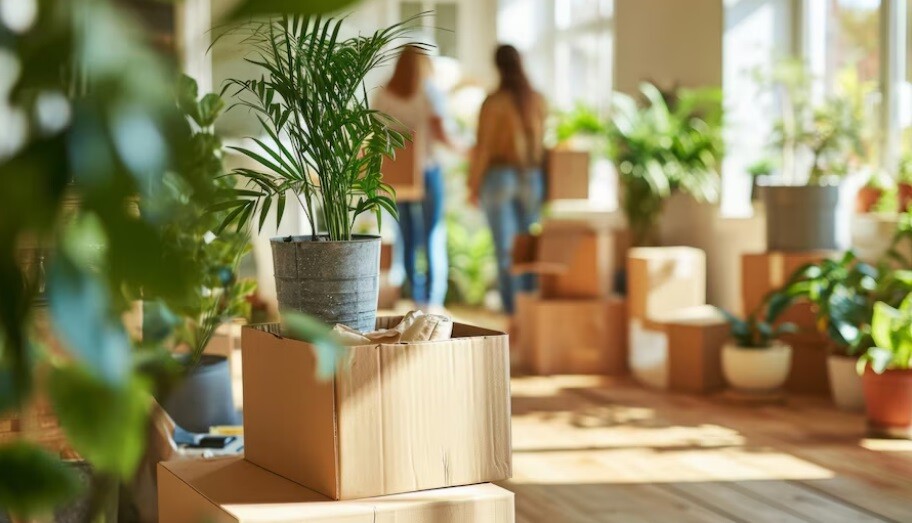Introduction
Moving can be stressful, and if you’re a plant lover, it adds another layer of complexity to the process. Whether you’re moving across town or cross-country, ensuring your plants make it to your new home safely is crucial. This guide will provide you with comprehensive steps on how to pack and transport your plants, ensuring they arrive at your new home healthy and thriving.
Preparing Your Plants for the Move
Assessing Your Plants
Before you start packing, assess the condition of your plants. Remove any dead or diseased leaves and branches. This not only reduces the risk of spreading disease but also makes the plants more manageable to pack and transport.
Watering Schedule
Water your plants a few days before the move. This ensures they are hydrated but not waterlogged, which can make them heavy and prone to damage. Avoid watering on the moving day to prevent soil spillage and mess.
How to Pack Plants for Moving

Gathering Supplies
To pack your plants for moving, you will need:
- Sturdy boxes
- Plastic pots (if your plants are in fragile or heavy pots)
- Bubble wrap or newspaper
- Plastic bags
- Tape
- Labels
Packing Small to Medium Plants
- Re-pot if Necessary: Transfer plants from fragile or heavy pots to lightweight, unbreakable plastic pots.
- Wrap Plants: Protect the foliage with newspaper or bubble wrap.
- Secure Pots: Place a plastic bag over the pot to keep soil contained. Secure it with tape.
- Boxing Up: Put the plants in a sturdy box. Fill any gaps with packing paper to prevent movement. Punch air holes in the box for ventilation.
- Labeling: Clearly label each box with “FRAGILE” and “LIVE PLANTS” to ensure careful handling.
Packing Large Plants and Trees
- Prune if Necessary: Lightly prune large plants and trees to make them more manageable.
- Wrap Pots and Roots: Use bubble wrap around the pot. For larger plants with exposed roots, wrap the roots in a moist cloth and cover with a plastic bag.
- Stabilize the Plant: Secure the plant inside a large box, using packing paper or bubble wrap to fill any gaps and stabilize the plant.
- Labeling: Mark the box with “FRAGILE” and “LIVE PLANTS”.
How to Transport Plants When Moving
Choosing the Right Transportation
For short moves, transporting plants in your car is ideal. For long-distance moves, especially cross-country, you may need to consider a specialized plant moving company.
Transporting Plants in Your Car
- Temperature Control: Ensure your car is at a comfortable temperature. Avoid exposing plants to extreme heat or cold.
- Securing Plants: Place plants in a stable position where they won’t tip over. Use seat belts or other restraints to keep them secure.
- Air Circulation: Ensure good air circulation by slightly opening windows if the weather permits.
Using a Plant Moving Company
If you’re moving long-distance, hiring a plant moving company can be beneficial. They specialize in handling plants and can provide the right environment and care during transit.
How to Transport Plants Cross Country

Preparing for Long Distance Moves
- Research Regulations: Some states have restrictions on transporting plants to prevent the spread of pests and diseases. Check the regulations of your destination state.
- Climate Considerations: Consider the climate of your destination and ensure your plants are suitable for it.
Professional Shipping Services
- Select a Reputable Company: Choose a plant moving company with good reviews and experience in handling long-distance moves.
- Special Packaging: The company may offer special packaging to ensure the plants’ safety during the long journey.
- Insurance Options: Consider purchasing insurance for high-value or rare plants.
Additional Tips and Resources
Maintaining Plant Health During the Move
- Regular Checks: During the move, periodically check your plants for signs of stress or damage.
- Post-Move Care: Once you arrive, unpack your plants immediately and place them in a suitable location. Water them if needed and monitor their health closely for the first few weeks.
Trusted Resources
For more detailed information on moving with plants, check out these trusted sources:
- American Horticultural Society
- National Gardening Association
- USDA Plant Hardiness Zone Map
Conclusion
Moving with plants requires careful planning and execution, but with the right steps, you can ensure your green companions thrive in your new home. Whether you’re moving locally or cross-country, these tips on how to pack and transport your plants will help make the process smoother and stress-free. Happy moving!
By following these guidelines, you can ensure your plants make a safe and healthy transition to your new home, ready to continue growing and flourishing in their new environment.




